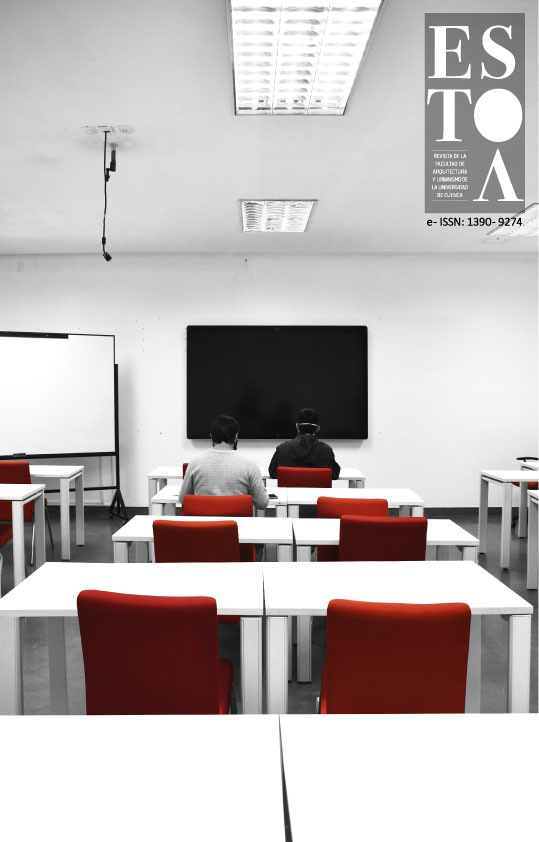Guidelines for BIM implementation in the environmental assessment of social housing
DOI:
https://doi.org/10.18537/est.v009.n018.a07Keywords:
Environmental Assessment, bioclimatic architecture, BIM implementation, energyplus, social housingAbstract
Innovations in science and technology play a key role in the transition to cleaner production. Based on this, this article seeks to promote the practical integration of concepts of bioclimatic architecture in the design of social housing, in real-time and from its initial stages through the development of a working mechanism applicable to the design stage as a decision support system during the planning process. The methodology consists of modeling with BIM (Building Information Modeling) and with ENERGYPLUS three prototypes of social housing in generalized use in the city of San Juan, Argentina. From the comparative analysis of the results achieved, the similarities and divergences associated with the use of the selected software for the environmental evaluation of social housing emerge, thus setting the basic guidelines for carrying out the BEM (Building Energy Modeling) of the same.
Downloads
References
Blat Tatay, D. (2016). Nuevas metodologías y tecnologías en el proceso constructivo y mantenimiento de infraestructuras y edificios singulares (Tesis de Maestría). Universidad Pontificia Comillas, Madrid, España. Recuperado de https://repositorio.comillas.edu/xmlui/handle/11531/14566
Choi, J., Shin, J., Kim, M. y Kim, I. (2016). Development of openBIM-based energy analysis software to improve the interoperability of energy performance assessment. Automation in Construction 72, 52–64. doi: 10.1016/j.autcon.2016.07.004
Chong, H. y Wang, X. (2016). The outlook of building information modeling for sustainable development. Clean Techn Environ Policy, 18, 1877–1887. doi: 10.1007/s10098-016-1170-7
Dave, B., Buda, A., Nurminen, A. y Främling, K. (2018). A framework for integrating BIM and IoT through open standards. Automation in Construction, 95, 35–45. doi: 10.1016/j.autcon.2018.07.022
Faaq Taha, F., Amer Hatem, W. y Adnan Jasim, N. (2020). Utilizing BIM technology to improve sustainability analyses for Iraqi Construction Projects. Asian Journal of Civil Engineering, 21, 1205–1215. doi: 10.1007/s42107-020-00270-y
Gao, H., Koch, C. y Wu, Y. (2019). Building information modelling based building energy modelling: A review. Applied Energy, 238, 320–343 doi: 10.1016/j.apenergy.2019.01.032
Grant Thornton (2018). BIM Transparencia, competitividad y productividad para el sector de la construcción. Madrid, España, Grant Thornton. Recuperado de https://www.grantthornton.es/globalassets/1.-member-firms/spain/folletos/bim.pdf
Graphisoft (2017). Manual de Ayuda ArchiCAD 21. Budapest, Hungría: Graphisoft. Recuperado de https://helpcenter.graphisoft.com/user-guide-chapter/64732/
IRAM - serie 11605 (1996). Acondicionamiento térmico de edificios. Norma. Buenos Aires, Argentina: Instituto Argentino de Normalización y Certificación.
IRAM 11603 (2012). Acondicionamiento térmico de edificios. Clasificación bioambiental de la República Argentina. Norma. Buenos Aires, Argentina: Instituto Argentino de Normalización y Certificación.
Isikdag, U. (2015). BIM and IoT: A Synopsis from GIS Perspective. Int. Arco. Photogramm. Sensores remotos Inf. Espacial. Sci., XL-2 / W4, 33–38. doi:10.5194/isprsarchives-XL-2-W4-33-2015
Jiménez-Roberto, Y., Sarmiento, J., Gómez-Cabrera, A. y Leal-del Castillo, G. (2017). Análisis de sostenibilidad ambiental de edificaciones empleando metodología BIM (Building Information Modeling). Ingeniería y Competitividad, 19 (1), 230–240. doi: 10.25100/iyc.v19i1.2147
Liu, Z., Lu, Y. y Chang Peh, L. (2019). A Review and Scientometric Analysis of Global Building Information Modeling (BIM) Research in the Architecture, Engineering and Construction (AEC) Industry. Buildings, 9, 210. doi:10.3390/buildings9100210
Llave Zarzuela, E., Arco Díaz, J. e Hidalgo García, D. (2019). Estudio comparativo-tecnologías BIM en edificación: Arquitectura Sostenible. Anales de edificación, 5 (3), 8-14. doi: 10.20868/ade.2019.4362
Lu, Y., Wub, Z., Changa, R. y Lib, Y. (2017). Building Information Modeling (BIM) for green buildings: A critical review and future directions. Automation in Construction 83, 134–148. doi: 10.1016/j.autcon.2017.08.024
Martín Dorta, N., Franco Pérez, C., Broock Hijar, D. y González de Chaves y Assef, P. (2014). Análisis de la integración de la tecnología BIM y los indicadores de Sostenibilidad. En B. Fuentes Giner e I. Oliver Faubel (Eds.), EUBIM. Encuentro de Usuarios BIM 2014. 2° Congreso Nacional BIM (pp. 26-37). Valencia, España. Recuperado de https://riunet.upv.es/bitstream/handle/10251/37634/EUBIM_Encuentro%20de%20usuarios%20BIM%202014_2%c2%ba%20Congreso%20nacional%20BIM_6165.pdf?sequence=1&isAllowed=y
Mojica Arboleda, A., Valencia Rivera, D. F., Gómez Cabrera, A. y Alvarado Vargas, Y. A. (2016). Planificación y control de proyectos aplicando “Building Information Modeling” un estudio de caso. Ingeniería, 20(1), 34-45. Recuperado de http://www.revista.ingenieria.uady.mx/ojs/index.php/ingenieria/article/view/47/64
Salinas, J. y Prado, G. (2019). Building information modeling (BIM) to manage desing and construction phases of Peruvian public projects. Building & Management, 3(2), 48-59. doi: 10.20868/bma.2019.2.3923
Sakin, M. y Kiroglu, Y. (2017). 3D Printing of Buildings: Construction of the Sustainable Houses of the Future by BIM. Energy Procedia, 134, 702–711. doi: 10.1016/j.egypro.2017.09.562
Torres Triana, W. S. (2017). Comparación de metodologías de simulación energética caso de estudio: simulación térmica para centro de bienestar animal (Tesis de Maestría). Universidad Católica de Colombia, Bogotá, Colombia. Recuperado de https://repository.ucatolica.edu.co/bitstream/10983/15388/1/Comparacion%20de%20Metodologias%20de%20Simulacion_Walter%20Torres.pdf
Published
How to Cite
Issue
Section
License
The Journal declines any responsibility for possible conflicts derived from the authorship of the works that are published in it.
The University of Cuenca in Ecuador conserves the patrimonial rights (copyright) of the published works and will favor the reuse of the same ones, these can be: copy, use, diffuse, transmit and expose publicly.
Unless otherwise indicated, all contents of the electronic edition are distributed under a Creative Commons Attribution-NonCommercial-ShareAlike 4.0 International License.




